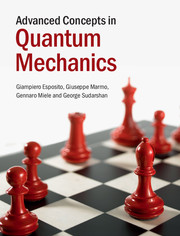Book contents
- Frontmatter
- Contents
- Preface
- 1 Introduction: the need for a quantum theory
- 2 Experimental foundations of quantum theory
- 3 Waves and particles
- 4 Schrödinger picture, Heisenberg picture and probabilistic aspects
- 5 Integrating the equations of motion
- 6 Elementary applications: one-dimensional problems
- 7 Elementary applications: multi-dimensional problems
- 8 Coherent states and related formalism
- 9 Introduction to spin
- 10 Symmetries in quantum mechanics
- 11 Approximation methods
- 12 Modern pictures of quantum mechanics
- 13 Formulations of quantum mechanics and their physical implications
- 14 Exam problems
- 15 Definitions of geometric concepts
- References
- Index
10 - Symmetries in quantum mechanics
Published online by Cambridge University Press: 05 November 2014
- Frontmatter
- Contents
- Preface
- 1 Introduction: the need for a quantum theory
- 2 Experimental foundations of quantum theory
- 3 Waves and particles
- 4 Schrödinger picture, Heisenberg picture and probabilistic aspects
- 5 Integrating the equations of motion
- 6 Elementary applications: one-dimensional problems
- 7 Elementary applications: multi-dimensional problems
- 8 Coherent states and related formalism
- 9 Introduction to spin
- 10 Symmetries in quantum mechanics
- 11 Approximation methods
- 12 Modern pictures of quantum mechanics
- 13 Formulations of quantum mechanics and their physical implications
- 14 Exam problems
- 15 Definitions of geometric concepts
- References
- Index
Summary
The meaning of symmetries is studied in some detail, and a study is performed of transformations which preserve the description, of transformations of frames and the corresponding quantum symmetries. The second part of the chapter outlines Galilei transformations, time translations, spatial reflection and time reversal
Meaning of symmetries
Symmetries and constants of motion have already appeared here and there in this book, most notably in Appendix 3.A. Recall that, therein, we have defined symmetries as those transformations that generate new solutions out of known solutions; more generally, that permute solutions among themselves. Constants of motion are functions on the carrier space which, when restricted to solutions, acquire a constant value depending on the solution considered. This point of view may be viewed as a dynamical point of view, i.e. depending on the specific system under consideration.
There is, however, another meaning of symmetry, which deals with the symmetry of the description that ensures the covariance of the equations of motion, e.g. transformations that map equations of motion in Hamiltonian form into other equations still in Hamiltonian form, or transformations that map second-order differential equations into second-order ones, i.e. equations admitting a Lagrangian description into new ones also admitting a Lagrangian description. Transformations of the dynamical type emerge out of the previous ones when we further require that the Hamiltonian is preserved or the Lagrangian is preserved up to a total time derivative.
- Type
- Chapter
- Information
- Advanced Concepts in Quantum Mechanics , pp. 214 - 233Publisher: Cambridge University PressPrint publication year: 2014



